Alex Watts's Blog, page 2
February 28, 2018
What’s All The Fuss Over Nando’s Using McCain Frozen Chips – Top Restaurants Are At It As Well

Anyone who has ever eaten at Nando’s will know the chips are the soft, puffy, mulchy sort that bring back unpleasant memories of school dinners. You know that sort of half-baked, oven chip taste. A film of jaundiced, fried potato barely holding in a pillow of tasteless white mush.
So, it is perhaps no surprise that the chicken chain has admitted using McCain frozen chips in its restaurants. It came after a student working at Nando’s grassed them up to the Leicester Mercury newspaper, and other media outlets lifted, I mean followed up, the story.
Nando’s was quick to point out that these were not the sort of McCain chips you might bung in the oven at home. But instead were a “specific recipe” exclusively made for the chain – which does make you wonder just how much effort went into making the chips as unpleasant as they are.
It hardly needs to be said that the outrage over this damning indictment caused much merriment and vitriol on Twitter and other social media dungeons, perhaps more so than usual because the snow meant more people than normal were sitting in their underpants, firing off tweets that no-one would ever read, rather than braving two inches of snow and struggling into work.
I haven’t the fortitude of character to bother checking whether there is now a chipgate hashtag in circulation, as I suspect there probably is. Just a handful of quoted tweets, for what now passes as journalism on the BBC website, was enough to put me off, with one moronic tweeter going as far as describing it as the “revelation of the year”.
KFC staff caught gobbing into chicken buckets or McDonald’s workers filling salt sachets with ricin might be worthy contenders for revelations, perhaps even of the year. But buying in chips from McCain is hardly a hanging offence, and Nando’s could help itself much more by simply training its kitchen staff to cook the chips properly.
To say the story is overdone is an understatement. What I find interesting is the attention these reports about what goes on in the kitchens of budget restaurants get. You can sense a definite snobbery and delight in middle-class foodie circles (i.e. foodie circles), presumably from people who would never lower themselves to eat in Nando’s or KFC, or at least would never admit to doing so. The schadenfreude at such ‘revelations’ is palpable among those who dine in far more expensive restaurants.
What I have never understood is how this level of outraged, puritan scrutiny rarely targets the top restaurants. Perhaps these places are just far better at concealing their tracks? Surely it is far more of a crime to pay ten times more than you would at Nando’s and then be served bought-in food.
At Rick Stein’s Seafood Restaurant, the chips arrived in sealed plastic bags ready to be fried – or at least they did when I worked there . They are not from McCain. Instead they are made at an industrial estate on the outskirts of Padstow, by Stein’s staff who also churn out all the Cornish pasties and chutneys that have made him one of the richest men in Cornwall - upsetting the locals no end (and not for just using the wrong type of pastry).
He can hardly be criticised for that. The explanation when I asked was that it was a space-saving ploy and there was not enough room in the seafood restaurant’s large, airy kitchen to peel potatoes and hand cut chips. Same as much of the other veg.
However, what did slightly irk was seeing other food come directly out of a jar or packet. As I say, you’d forgive this in a café selling £6 or £7 lunches, but not in a restaurant that charges Michelin star prices, without actually having one.
When I did my brief stint in the kitchen there (admittedly a long time ago, but I’d be surprised if much has changed), if you ordered the potted shrimp, all the chef had to do was open a bought-in pot and put the contents on a plate with (home-made) toast. You could have saved yourself a small fortune just by going to Asda. The seafood pasta dish was almost as easy. But for that price you might think Stein’s staff were making the pasta themselves. Instead, they just boiled up packets of dried De Cecco linguine, which is a very good one, but you take my point.
I have heard countless tales from chefs working in many of the top restaurants in Britain, who can tell similar stories. Even the three-star Fat Duck was no stranger to the practice. The bread arrived each morning, supplied by a boutique baker, which is forgivable given the size of Heston Blumenthal’s coffin-sized kitchen. And Waitrose helped out with the sardine on toast sorbet. The pastry chefs could never have been accused of shouting it from the rooftops, and you got the feeling that any bought-in food would have been kept under lock and key away from prying eyes, as the great and the good were sometime given tours of the kitchens.
It was only when the pastry cooks on ice cream duty said they had run out of tinned sardines one day, that a hapless chef was sent off to the nearby Waitrose in Maidenhead for a few tins of own-brand fish, that it became obvious.
Published on February 28, 2018 05:44
December 9, 2016
Salted Cod And Cashew Nut Curry
This recipe was partly inspired by Cambodia's national dish, amok - river fish cooked with mild spices and coconut. Amok varies enormously from home to home over there. Most resemble a sort of runny, yellow curry, but the supposedly authentic ones are steamed in banana leaves and, with the addition of beaten egg, come out like souffles. So chaotic is the dish, you could say it runs ... oh, never mind.
Salted fish is also an important ingredient for the Khmers, and works well in this curry. As for the cashew nuts, you can pick them off the trees over there. Remember to only add salt at the end, if necessary, as it is difficult to estimate how salty the fish is and how much soaking it will need. Obviously the saltier you like it, the less soaking it needs.
300g salt cod or pollack, skinless and boneless
2 medium onions, finely chopped
6 garlic cloves
4 green cardamon pods
4 cloves
2 tsps ground coriander
2 tsps ground turmeric
1 tsp cumin seeds
2 tbsps olive oil
6 red chillies, fewer if you don't like heat
1 tsp vinegar
1 tsp sugar
1 large yellow or orange pepper, diced
1 bay leaf
120g tinned tomatoes, chopped
400ml coconut milk
20 cashew nuts
Soak the salted fish overnight in a saucepan full of cold water. Change the water a couple of times. Heat the oil in a pressure cooker and add the chopped onion. Stir and cook over a medium heat for 10 minutes until reduced heavily in size. Add the diced pepper, bay leaf and garlic and cook for another few minutes, stirring regularly.
Add the cardamon, cumin, turmeric, coriander, sugar and vinegar. Stir for a minute, adding a splash of water if the spices start to catch. Add the tomatoes and coconut milk.
Cover the pressure cooker, bring up to pressure, and simmer for 30 minutes, stirring half way through. Then add the fish, cut into inch-wide pieces, cashew nuts and whole red chillies. Stir well and cover the pressure cooker again. Simmer for 30 minutes, stirring half way through.
Serve with fresh coriander, salad and boiled rice.
Salted fish is also an important ingredient for the Khmers, and works well in this curry. As for the cashew nuts, you can pick them off the trees over there. Remember to only add salt at the end, if necessary, as it is difficult to estimate how salty the fish is and how much soaking it will need. Obviously the saltier you like it, the less soaking it needs.
300g salt cod or pollack, skinless and boneless
2 medium onions, finely chopped
6 garlic cloves
4 green cardamon pods
4 cloves
2 tsps ground coriander
2 tsps ground turmeric
1 tsp cumin seeds
2 tbsps olive oil
6 red chillies, fewer if you don't like heat
1 tsp vinegar
1 tsp sugar
1 large yellow or orange pepper, diced
1 bay leaf
120g tinned tomatoes, chopped
400ml coconut milk
20 cashew nuts
Soak the salted fish overnight in a saucepan full of cold water. Change the water a couple of times. Heat the oil in a pressure cooker and add the chopped onion. Stir and cook over a medium heat for 10 minutes until reduced heavily in size. Add the diced pepper, bay leaf and garlic and cook for another few minutes, stirring regularly.
Add the cardamon, cumin, turmeric, coriander, sugar and vinegar. Stir for a minute, adding a splash of water if the spices start to catch. Add the tomatoes and coconut milk.
Cover the pressure cooker, bring up to pressure, and simmer for 30 minutes, stirring half way through. Then add the fish, cut into inch-wide pieces, cashew nuts and whole red chillies. Stir well and cover the pressure cooker again. Simmer for 30 minutes, stirring half way through.
Serve with fresh coriander, salad and boiled rice.
Published on December 09, 2016 10:20
December 8, 2016
Vintage Cheddar And Parmesan Leeks
If you're lucky enough to have a garden, you may be fortunate enough to pull a couple of fat leeks out of the ground for this delicious recipe, as they're in peak condition at this time of year. If not, you'll just have to rely on the local bearded grocer like me.
It goes very well with roast pork and crackling as I knocked up for a meal last Sunday, with apple sauce, steamed kale, roast spuds and other trimmings. In fact, it's not often that a side dish takes centre stage, but it certainly gave the pork leg a run for its money, and if anything was almost as popular as the crackling. It doesn't require a lot of cheese, but the cheddar you use should be as full-flavoured and vintage as you can find.
2 large leeks
25g butter
25g plain white flour
350ml milk
250ml water
2 tsps wholegrain mustard
Few dashes of Worcestershire sauce
Salt and white pepper
3 tbsps breadcrumbs
50g vintage cheddar, grated
25g parmesan, grated
2 tsps fish sauce
Cut the leeks lengthways into four (keeping them attached at the root) then wash well in a tub of water to remove any grit and mud. Slice the leeks into inch-wide pieces. Boil 250ml of water in a saucepan, add a little salt, and then the leeks.
Stir well, then cover the pot over a medium heat for 30 seconds. Stir again, then cover for another 30 seconds. Do this for a total of five minutes - the leeks should have reduced in size by about a half. Remove the leeks and remaining water (which will have turned a pale green).
In the same (dry) pan, melt the butter and then add the flour. Take off the heat, and stir well with a wooden spoon to make a blonde paste (roux). Return to the heat and add the still-hot liquor from the leeks. Once the water is absorbed, add the milk, a little at a time, using a whisk to break down the lumps.
Once you have a thick sauce, add the mustard and fish sauce. Then add the grated cheese, stirring until you have a smooth sauce again. Check the seasoning, adding salt and white pepper to taste.
Add the leeks to the sauce and simmer for two minutes. Transfer to an oven dish, top with breadcrumbs and a few splashes of Worcestershire sauce, then cook in a pre-heated oven at 170C for 20-30 minutes until the top if golden.
It goes very well with roast pork and crackling as I knocked up for a meal last Sunday, with apple sauce, steamed kale, roast spuds and other trimmings. In fact, it's not often that a side dish takes centre stage, but it certainly gave the pork leg a run for its money, and if anything was almost as popular as the crackling. It doesn't require a lot of cheese, but the cheddar you use should be as full-flavoured and vintage as you can find.
2 large leeks
25g butter
25g plain white flour
350ml milk
250ml water
2 tsps wholegrain mustard
Few dashes of Worcestershire sauce
Salt and white pepper
3 tbsps breadcrumbs
50g vintage cheddar, grated
25g parmesan, grated
2 tsps fish sauce
Cut the leeks lengthways into four (keeping them attached at the root) then wash well in a tub of water to remove any grit and mud. Slice the leeks into inch-wide pieces. Boil 250ml of water in a saucepan, add a little salt, and then the leeks.
Stir well, then cover the pot over a medium heat for 30 seconds. Stir again, then cover for another 30 seconds. Do this for a total of five minutes - the leeks should have reduced in size by about a half. Remove the leeks and remaining water (which will have turned a pale green).
In the same (dry) pan, melt the butter and then add the flour. Take off the heat, and stir well with a wooden spoon to make a blonde paste (roux). Return to the heat and add the still-hot liquor from the leeks. Once the water is absorbed, add the milk, a little at a time, using a whisk to break down the lumps.
Once you have a thick sauce, add the mustard and fish sauce. Then add the grated cheese, stirring until you have a smooth sauce again. Check the seasoning, adding salt and white pepper to taste.
Add the leeks to the sauce and simmer for two minutes. Transfer to an oven dish, top with breadcrumbs and a few splashes of Worcestershire sauce, then cook in a pre-heated oven at 170C for 20-30 minutes until the top if golden.
Published on December 08, 2016 06:40
November 21, 2016
Broccoli Stalk Stew
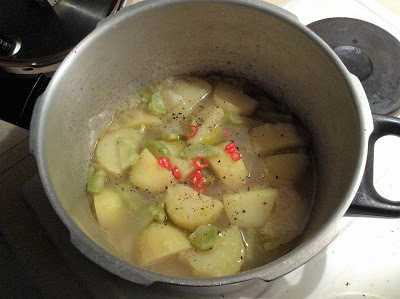
Broccoli stalks, if you ask me, are the best part of the vegetable, and perhaps any vegetable. They can have a sort of pak choi flavour and texture if you don't cook them too much, and slice them thinly.
This is a take on a soup/stew I had a number of times when I was living in Cambodia. There, they use the stalks to good effect, slicing them to the thickness of a beer bottle top for want of a better, but all the same as appropriate, image - then cooking them in soups, fried rice, noodle dishes, and probably a lot of other dishes I've forgotten since those impecunious, halcyon days.
I've used potato here, which doesn't grow well in Cambodia, but the ingredients are far from consistent there, to be sure using whatever is cheap in the market that week, so I've tweaked accordingly.
It is usually served with a small bowl of chopped red chillies topped with a chunk of lime, maybe a side plate of a few leafy vegetables or herbs like they do so well in neighbouring Vietnam, and of course the ubiquitous, plastic (often red) basket containing fish sauce, soy sauce, sugar, black pepper, toothpicks, and pickled green chillies if you're lucky. As dishes go it's got to be about as cheap as it comes, but it's very good all the same.
Stalks of two large broccoli heads, sliced thinly
2 large potatoes, each cut into eight pieces
1 small onion, chopped
1 tbsp vegetable oil
500ml water
Salt, pepper to taste
1 tsp chopped fresh ginger
1 tbsp chopped garlic
Chopped red bird eye chillies
Prep the vegetables then fry the onion in a pot until it has softened and is beginning to colour. Add the potato pieces, garlic, and ginger. Continuing frying for a few more minutes. Add the water, bring to the boil, cover the pot and simmer for 15 minutes.
Add the broccoli stalks, recover the pot and cook for another five minutes or so until the stalks are tender and the potato still firm. Add a little more water if necessary. You don't want it swamping, but there needs to be liquor. Season with salt and pepper to taste, then serve with chillies, fish sauce and all the rest. Then imagine you're sitting on a plastic stool in 35C heat.
Published on November 21, 2016 10:29
November 19, 2016
Snakebite Lamb

This is a take on an old English recipe for boiled mutton. You might think I've added an unnecessary, not to say dubiously fusion, twist with the tablespoon or so of fish sauce. But fish sauce, or nam pla in Thailand, is nothing more than anchovies and salt, with the final addition of a little sugar, left to naturally ferment for months, and sometimes years, dripping forth its pungent red-brown liquor.
It is little different to the many European fish sauces made with anchovies and salt, brought by the Romans to Albion, and known as garum and other names. Many are the robust, devilled English recipes that demanded fermented fish sauce, and later its distant niece Worcestershire sauce, and there are few finer combinations than roast lamb studded with anchovy fillets and garlic.
Yes, rosemary if you will, but it's the salty fish and lamb/mutton taste that makes the dish, which is why saltmarsh lamb that stuff themselves on samphire and seaweeds on places like Romney Marsh and the Gower provide such wonderful feasts.
The snakebite combination of cider and lager, of course, works well too. The lamb is first simmered in sharp scrumpy and then is improved with the bitter taste of fermented hops later on. A little mustard, thyme, and lots of garlic, and the dish is complete.
1kg boned leg of lamb500ml scrumpy cider250ml lager beer10 cloves of garlic10 whole peppercorns2 bay leaves2 tsps English mustard1 tsp dried thyme1 tbsp fish sauce1 large onion, chopped roughly2 medium carrots, sliced diagonally1 tbsp olive oilSalt to taste
Heat the oil in a pressure cooker on a medium-heat hob and fry the onions for a couple of minutes, stirring all the time. Tilt the pan and push the onions to one side then brown the joint of rolled lamb. Keep turning the joint, making sure it is brown all over, and the onions don't catch.
Add the carrots and bay leaves and fry for another two minutes, adding a little water if the bottom begins to catch. Then add the scrumpy, peppercorns, mustard, fish sauce and five cloves of garlic.
Put the lid on and cook under a medium pressure for 20 minutes. Then open the cooker, turn the lamb, and cook under pressure for another 20 minutes. Take the lid off and add the beer and the other five clove of garlic.
Simmer uncovered for one hour, turning the lamb regulary, until the liquid is reduced by a third - this should take between 40 minutes and an hour, depending on the heat of the hob.
Allow the lamb to rest for 20 minutes in the pan, then carve into thick sliices and serve in a bowl. Add a couple of ladles of the lamb liquor, and serve with boiled potatoes and green vegetables.
Published on November 19, 2016 09:17
January 28, 2016
Chicken And Asparagus Pie
 The pastry for this pie comes from one of the apprentices on my cheffing course. He modestly says he's only good at turning potatoes, and jokes that if he was a superhero his one special power would be the ability to instantly turn vegetables into perfect, seven-sided barrels. However, he's pretty good at making pies as well.
The pastry for this pie comes from one of the apprentices on my cheffing course. He modestly says he's only good at turning potatoes, and jokes that if he was a superhero his one special power would be the ability to instantly turn vegetables into perfect, seven-sided barrels. However, he's pretty good at making pies as well.He should be really, because the rest of the week, he works at a gastropub that specialises in pies. Every morning, he makes the pie dough using this recipe below. The chef assessor spent a few hours in his kitchen, ticking off units in his apprenticeship file, and came back raving about the pie crust.
It was deemed so good, he asked the apprentice to fill in for our masterchef lecturer one morning to show us how to make the perfect pie. "I don't want to blow smoke up your arse, but that's probably the best rough puff pastry I've ever tasted," the masterchef told him afterwards before trying to sell us the pies we'd made at a fiver a pop, pointing out that they'd probably be £25 in a deli.
At the gastropub, they use shortcrust pastry for the bottom of the pie and rough puff for the top. But we used rough puff for both. It rises very well and is deliciously crispy owing to all the butter in it. The pies in the picture above should probably have been cooked about five minutes less, as the pastry is a little too brown, but some idiot, uh hum, forgot to put the timer on the oven. I had nothing to do with the ludicrous Man U decoration though.
Rough Puff Pastry
1kg plain flour
750g butter
Cold water
Cut the butter into cubes, about the size of Oxo cubes. Sieve the flour into a bowl and add the butter cubes. Mix briefly with a wooden spoon until the cubes are evenly covered in flour. Add cold water, a little at a time, and stir until the pastry comes together in a ball. Don't over mix it - you still want pieces of butter in the pastry.
Cover the pastry in clingfilm and chill in the fridge for 20 minutes. Take out, flour the work surface and roll out into a long rectangle. Fold the top third into the middle, the bottom third into the middle. Fold in half, then turn 90 degrees and roll out into a rectangle again.
Repeat this three more times, then put the pastry back into the fridge. Chill for another 20 minutes, then take out and repeat the procedure. Chill until ready for use. If you have more pastry than you need, wrap it in clingfilm and freeze.
Poached Chicken
I whole chicken
2 onions
4 sticks celery
3 bay leaves
10 peppercorns
Put your fingers under the skin at the neck end and carefully pull the skin from the chicken. Chop off the feet and pull the leg skin off. Put the whole skinned chicken in a stock pot and cover with water. Add the celery, onion and spices. When the water starts to boil, turn the heat down and cook for one hour.

Take the chicken out, and using a probe, check the inside of the thigh is at least 65C. Even when it is 85C, the chicken meat is still moist because it has been cooked in a wet heat rather than dry heat. But I find about 70C is the best.
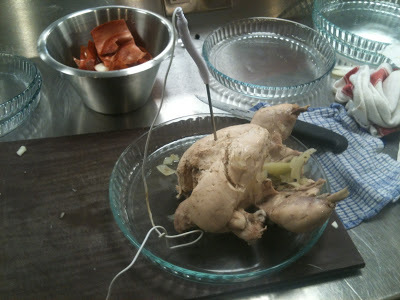
Pick the meat from the chicken carcass, and lay on a tray then chill in the fridge. Return the chicken carcass and bones to the stockpot. Continue simmering the stock until you are ready to make the veloute sauce (see below).
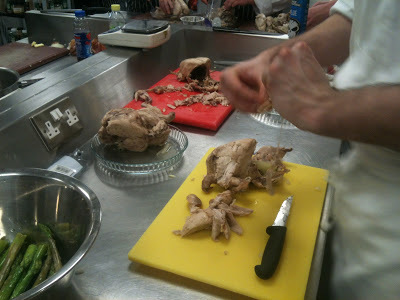 Asparagus
AsparagusCut off the bottom inch or so of the asparagus. Then boil the spears for two minutes. Take out and refresh in iced water. When cold, slice into discs, about the thickness of £1 coins. Put in the fridge.
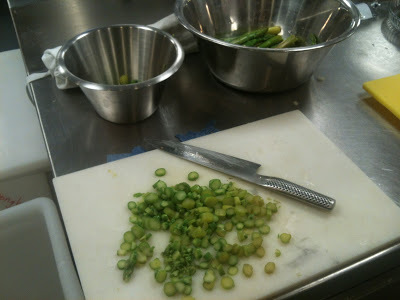 Onion Veloute Sauce
Onion Veloute Sauce1 large onion
100g butter
100g flour
1 litre chicken stock
Chop the onion very finely and fry in the butter over a low heat until the onion has 'melted'. It should be soft and very yellow. Add the flour and stir well. Cook the roux over a low heat for three minutes until coloured slightly - make sure it doesn't catch on the bottom of the pan.
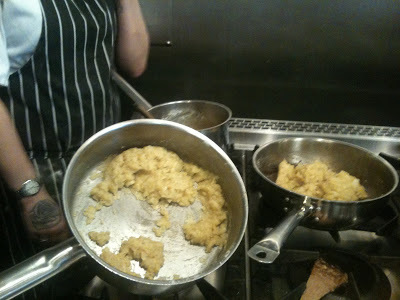 Heat up the sieved stock from the chicken if it has gone cold, and add a ladle at a time to the roux, stirring constantly, and adding the next ladle when the water is absorbed. Then whisk the rest of the stock in, and simmer for 10 minutes. Add salt to taste. Chill the sauce in the fridge.
Heat up the sieved stock from the chicken if it has gone cold, and add a ladle at a time to the roux, stirring constantly, and adding the next ladle when the water is absorbed. Then whisk the rest of the stock in, and simmer for 10 minutes. Add salt to taste. Chill the sauce in the fridge.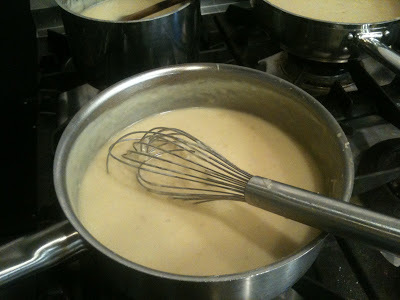 Pie Filling
Pie FillingWhen the chicken meat, asparagus and veloute sauce are all chilled, mix together in a bowl. Add salt and pepper to taste.
Making The Pie
Lightly flour the work surface and roll out the pastry to about 1/2cm thick. Cut out a circle three inches wider than the pie dish's circumference. Grease the pie dish with butter and sprinkle with flour. Then lay the pastry circle in the dish, pushing down into the corners. Leave the extra pastry hanging over the edge of the dish. Fill the pie with filling.
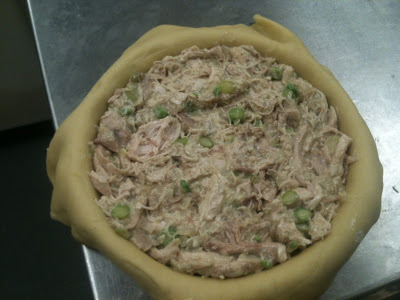 Roll out another circle of pastry the same thickness as before, and lay on top of the pie. Push it down on the pastry beneath. Then hold the dish up with one hand and with a knife in the other, neatly trim off the excess pastry. Crimp the edges together using your thumb and index finger on your left hand (if right-handed) and thumb on your right hand. Glaze the top with beaten egg yolk.
Roll out another circle of pastry the same thickness as before, and lay on top of the pie. Push it down on the pastry beneath. Then hold the dish up with one hand and with a knife in the other, neatly trim off the excess pastry. Crimp the edges together using your thumb and index finger on your left hand (if right-handed) and thumb on your right hand. Glaze the top with beaten egg yolk.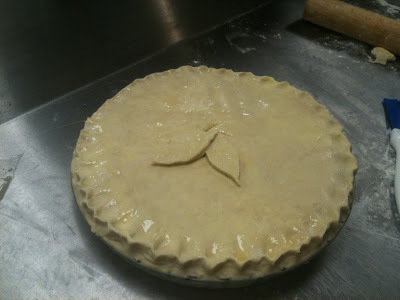 Baking The Pie
Baking The PiePut the pie dish on a tray. Bake in a pre-heated oven at 180C - or 160C if you've got a fan-assisted oven - for 45 minutes.
Published on January 28, 2016 10:46
January 25, 2016
January Vegetables And The Healthiest Ways To Cook Them

The following are some of the main seasonal vegetables for January:
Kale
Type: Leaf vegetable
Cooking: Kale can be cooked in a number of ways, including stir frying, steaming, microwaving, and boiling.
The healthiest option is steaming over a couple of inches of water, rather than boiling. Because the kale is not submerged in water, it loses less of its water-soluble nutrients such as vitamins B and C.
Some people eat kale raw by adding it to smoothies, but research shows cooking can actually make some vegetables healthier by boosting certain nutritional components.
Cooked kale, for example, has a higher level of carotene than in its raw state. Carotene is converted by the body into vitamin A, and is important for eyesight and the immune system. Cooking also boosts other fat-soluble nutrients like vitamins D, E and K.
So steamed kale – the healthiest cooking option – has far less vitamin C than raw kale, but has more carotene. This means it’s probably best to eat a diet of both cooked and raw kale.
Carrot
Type: Root vegetable
Cooking: Like kale, carrots can be cooked in a number of ways, including stir frying, steaming, microwaving, boiling and poaching. The healthiest option is steaming. Carrots can also be roasted or grilled. All three methods destroy less nutrients than boiling and do not have the added fat needed for frying. Roasting also gives carrots a great taste, extracting their natural sweetness.
Leek
Type: Bulb and stem vegetable
Cooking: Again, steaming is the best method for leeks as less water-soluble nutrients are lost compared with boiling. This is also healthier than frying as it does not require the addition of fat.
Cabbage
Type: Leaf vegetable
Cooking: Steaming would once again be a healthier method of cooking than boiling or frying.
Cabbage can also be eaten raw as a salad, preserving its water-soluble nutrients such as vitamins B and C. If it is going to be boiled, a healthier way of doing this is to the reduce the amount of water it is cooked in – which decreases the loss of nutrients – and also reducing the cooking time so the cabbage is not cooked longer than necessary. The cabbage water can also be used as a base for soup.
Published on January 25, 2016 09:47
November 23, 2015
Jeremy Clarkson Fracas Hotel Gets Plaque

The hotel where Jeremy Clarkson threw his toys out of his V8 pram and punched a Top Gear producer has been given a plaque to commemorate the end of Clarkson's BBC career.
Managers at Simonstone Hall, in the Pennines, say a guest gave them the shiny plaque on Sunday night, and they plan to put it on the patio where the "fracas" took place.
Clarkson punched Oisin Tymon in the mouth after he told him he couldn't have a steak because the kitchen had closed and the chef had gone home.
Tymon, 36, was forced into hiding after receiving death threats from online trolls blaming him for Clarkson's sacking from the BBC2 car cockfest show.
Simonstone Hall - which brands itself as the "perfect haven to relax and unwind" - has not revealed who the plaque giver is, but seems chuffed with the gift.
"We think it would be quite appropriate to put it on the patio where the fracas took place," the hotel said on its Facebook page.
Published on November 23, 2015 05:29
November 12, 2015
How To Fillet A Flat Fish
The trouble with learning how to fillet fish is there are so many different methods. But if you really want to know how to do it, ask a fisherman - they do it every day.
Here, Billy The Fish shows how to prep a flat fish into two or four fillets...
Published on November 12, 2015 12:05
How To Fillet A Round Fish
The trouble with learning how to fillet fish is there are so many different methods. But if you really want to know how to do it, don't ask a celebrity chef who has long since fled the kitchen, ask a fisherman - they do it every day.
Here, Billy The Fish shows apprentice chef Alex Watts how to fillet a cod the right way...
Published on November 12, 2015 11:52



